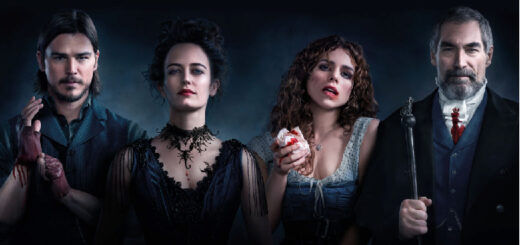I’ve had a chance recently to catch some, not all, of Showtime’s series, Penny Dreadful, and I’ve enjoyed it quite a bit. It takes the same concept of Alan Moore’s League of Extraordinary Gentlemen (combine genre characters from the Victorian Age into a single story) and uses it with mostly horror and supernatural characters and elements, again in Victorian London.
The “real” penny dreadfuls were the pulp fiction of their day, precursors to the pulp magazines and also comics. The TV series was created by John Logan (who, among other things, wrote Skyfall and will be writing the next two James Bond films as well) and is the co-executive producer along with James Bond director Sam Mendes (he also directed The Road to Perdition).
There are also other Bond connections, including Timothy Dalton as the African explorer Sir Malcolm Murray, who is the father of Mina Murray, who just happens to be a character in the novel Dracula. Eva Green, who was the “Bond Girl” Vesper Lynd in Casino Royale, plays Vanessa Ives, a medium and possibly a witch. Among interest to we pop culture geeks would also be Doctor Who’s companion Billie Piper as a prostitute with a possibly very dark future.
The show also features Victor Frankenstein and his creature(s) as well as Dorian Gray and a werewolf. To say more would spoil the story for those who have not yet experienced it. The show is well acted, well directed, well written and with first class production values. First class altogether as well as being suspenseful, creepy, and shocking.
What I like most about the show is the complexity of the characters. No one is wholly admirable nor wholly despicable. One of my favorite characters is Frankenstein’s Creature, who sometimes goes by the name Caliban; he is tragic and sympathetic and dangerous all at the same time. You learn things about all the characters and you’re not sure you should root for them – but you do.
All of which really leads up to the true topic of this week’s column – creating complex characters. It is both easy and difficult. It falls back to one of my cardinal rules – we write what we know, especially about people and life as we have experienced them.
What defines a given character is what they want and what they are willing to do to get what they want. By want, I mean really want – not just sorta kinda want. What do they need, what do they desire, what do they lust for, what must they have? Something primal. The more intense the want (the motivation), the better it will drive the story. The reader must not only know what the character wants, they have to feel it. They must feel the desire behind it.
What prevents the character from getting what they want (at least initially) is what makes the story. That’s the conflict. How the character copes with that conflict reveals what their true character is. Same as in life. If the need were easy to satisfy, the story would be quickly over.
Sometimes the conflict is with a person (the antagonist), sometimes an object (a mountain), sometimes a situation (a hurricane, for example). Think of your own life. What is most likely to keep you from getting what you want? As often as not, the answer is you yourself. You have doubts or fears but what is most likely to get in your way is a competing need. You want A but you want B as well and they are mutually exclusive. However, your inner child wants both. That conflict has to be resolved for the story to reach its climax. What we choose, what the character chooses, tell us and tells the reader who the character truly is.
Character exists within opposites. Never try to explain them away. Make the reader feel both desires and identify with both. State them, dramatize them, play with them before you resolve them.
Keep in mind that there may be more than two conflicting wants; in life, we may have dozens. Not all of them have to be resolved; only the main ones. Also keep in mind that it is not only your protagonist that has these conflicting needs; all your characters should. It should be true in your stories because it is true in life; it’s never simple, it’s never easy, it’s never neat and that is what makes it fascinating. Conflict is not just external; it’s internal. Apply what you know to the characters you write.
That’s the job.












